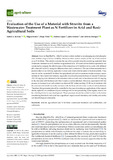Mostrar el registro sencillo del ítem
Evaluation of the use of a material with struvite from a wastewater treatment plant as n fertilizer in acid and basic agricultural soils
| dc.creator | De Soto García, I. S. | es_ES |
| dc.creator | Itarte Basterra, Miguel Julián | es_ES |
| dc.creator | Virto Quecedo, Íñigo | es_ES |
| dc.creator | López, Andrea | es_ES |
| dc.creator | Gómez, Jairo | es_ES |
| dc.creator | Enrique Martín, Alberto | es_ES |
| dc.date.accessioned | 2023-05-18T10:43:27Z | |
| dc.date.available | 2023-05-18T10:43:27Z | |
| dc.date.issued | 2023 | |
| dc.identifier.citation | de Soto, I. S., Itarte, M., Virto, I., López, A., Gómez, J., & Enrique, A. (2023). Evaluation of the Use of a Material with Struvite from a Wastewater Treatment Plant as N Fertilizer in Acid and Basic Agricultural Soils. Agriculture, 13(5), 999. https://doi.org/10.3390/agriculture13050999 | en |
| dc.identifier.issn | 2077-0472 | |
| dc.identifier.uri | https://hdl.handle.net/2454/45315 | |
| dc.description.abstract | Struvite (MgNH4PO4 · 6H2O) has been widely studied as an emerging recycled phosphorous fertilizer despite its low solubility. However, there are few studies on the use of this mineral as an N fertilizer. This article evaluates the use of two powder struvite-containing materials from wastewater treatment as an N fertilizer in agricultural soils. A 9-week soil incubation experiment was conducted to compare the effectiveness of this mineral as an N fertilizer in two soils with different pH values (8.2 and 6.7), using two different doses and a control soil. The use of these materials has a positive effect on soil fertility, especially in acidic soils where struvite seems to be more soluble. Thus, struvite can be a potential N fertilizer for agricultural soils and can promote circular economy opportunities for the wastewater industry, especially in acid soils (concentrations of mineral N between 453–339 mg/kg were obtained in the mixtures with acid soil, and values between 408–212 mg/kg in the mixtures with the basic soil after 6 weeks of soil incubation). However, associated with this process, an increase in soil salt content was observed (EC values reaching 3.9 dS/cm in mixtures with the acid soil and 2.8 dS/cm in the mixtures with the basic soil after nine weeks of soil incubation). Therefore, this parameter should be controlled in the case of continuous applications of the amendments, especially in conditions of poor drainage and/or non-percolating water regime, since it can be a limiting factor in crop development. These processes should be studied in detail in the future considering that the N soil cycle has a significant impact on soil chemistry and fertility and on the soil microbiological community. | en |
| dc.description.sponsorship | This study was funded by two OTRI projects between the Universidad Pública de Navarra and Navarra de Infraestructuras Locales S. A. with the codes 2021904212 and 2022904154, and it was also funded with FEDER European funds from the project MAGNYFOS RTC2019-007257-5. | en |
| dc.format.mimetype | application/pdf | en |
| dc.language.iso | eng | en |
| dc.publisher | MDPI | en |
| dc.relation.ispartof | Agriculture 2023, 13, 999 | en |
| dc.rights | © 2023 by the authors. This article is an open access article distributed under the terms and conditions of the Creative Commons Attribution (CC BY) license. | en |
| dc.rights.uri | http://creativecommons.org/licenses/by/4.0/ | |
| dc.subject | Struvite | en |
| dc.subject | Agricultural soil | en |
| dc.subject | N fertilizer | en |
| dc.subject | Wastewater treatment | en |
| dc.subject | Soil acidification | en |
| dc.subject | Soil carbonates | en |
| dc.title | Evaluation of the use of a material with struvite from a wastewater treatment plant as n fertilizer in acid and basic agricultural soils | en |
| dc.type | Artículo / Artikulua | es |
| dc.type | info:eu-repo/semantics/article | en |
| dc.date.updated | 2023-05-18T10:32:24Z | |
| dc.contributor.department | Ciencias | es_ES |
| dc.contributor.department | Zientziak | eu |
| dc.contributor.department | Institute on Innovation and Sustainable Development in Food Chain - ISFOOD | en |
| dc.rights.accessRights | Acceso abierto / Sarbide irekia | es |
| dc.rights.accessRights | info:eu-repo/semantics/openAccess | en |
| dc.identifier.doi | 10.3390/agriculture13050999 | |
| dc.relation.projectID | info:eu-repo/grantAgreement/AEI/Plan Estatal de Investigación Científica y Técnica y de Innovación 2017-2020/RTC2019-007257-5 | en |
| dc.relation.publisherversion | https://doi.org/10.3390/agriculture13050999 | |
| dc.type.version | Versión publicada / Argitaratu den bertsioa | es |
| dc.type.version | info:eu-repo/semantics/publishedVersion | en |
| dc.contributor.funder | Universidad Pública de Navarra / Nafarroako Unibertsitate Publikoa | es |



